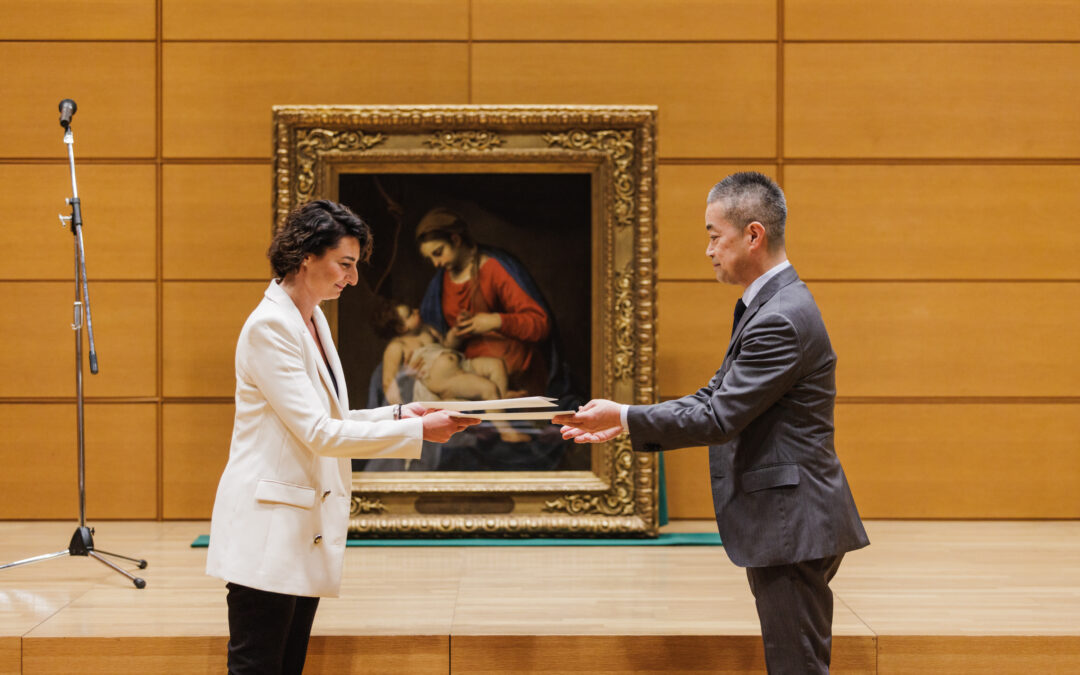A work by Italian baroque painter Alessandro Turchi that was looted by Nazi Germany during World War Two has been returned to Poland from Japan. It is the first time that Poland has secured the return of one of its wartime losses from East Asia.
The painting – Madonna and Child, dating from the turn of the 16th and 17th centuries – was discovered with the help of special IT tools used by staff at the Polish culture ministry after it was put up for auction in Tokyo.
The work was due to be auctioned in January 2022. But, after the Polish authorities intervened, the sale was halted. Once evidence was provided to prove that the painting had been looted, the Mainichi auction house, in consultation with the item’s owner, agreed to return it to Poland at no cost.
A ceremony to hand over the painting was held yesterday at the Polish embassy in Tokyo. It is now planned for it to go on display in Poland.
📢 „Madonna z Dzieciątkiem” – polska 🇵🇱 strata wojenna z kolekcji Lubomirskich odnaleziona w 🇯🇵 Japonii ‼
▶️ Uroczystość przekazania stronie polskiej dzieła, będącego stratą wojenną z pałacu w Przeworsku, odbyła się rano w @PLinTokyo.
🔴 Obraz, wystawiony na aukcji w… pic.twitter.com/b8ngNzYBW4
— Ministerstwo Kultury i Dziedzictwa Narodowego (@kultura_gov_pl) May 31, 2023
The first recorded evidence of the painting comes from an 1823 publication showing that it was part of the collection held at the palace of Henryk Lubomirski, a Polish noble, in Przeworsk, a town in what is now southeastern Poland.
The document indicates that the work’s previous owner was another noble, Stanisław Kostka Potocki, who most likely purchased it during one of his visits to Italy in the late 18th century.
At the outbreak of World War Two in 1939, the painting remained in the Przeworsk collection. It was then included by the German Nazi occupiers on a list of 521 valuable artworks in occupied Poland compiled by Kajetan Mühlmann, a Nazi official who oversaw the looting of art.
The painting was probably transferred to German in 1940, after which all traces of it were lost until the 1990s, when it turned up for auction in New York, notes the Polish culture ministry.
Poland has appealed to @UNESCO for help in securing the return of art and other cultural items looted by Germany during WWII.
"Today these things are in German homes, mansions, museums," says @arekmularczyk. "Germany has not yet been held accountable" https://t.co/cG5I1SLy68
— Notes from Poland 🇵🇱 (@notesfrompoland) December 17, 2022
Many of the items on Mühlmann’s list were returned to Poland shortly after the war, including Leonardo da Vinci’s Lady with an Ermine and Rembrandt’s Landscape with the Good Samaritan. However, others, including Rafael’s Portrait of a Young Man, have never been found.
Overall, Poland estimates that hundreds of thousands of artworks, books and other cultural heritage looted or destroyed during the war remain unaccounted for. The government has recently stepped up efforts to seek their return from Russia and Germany.
Turchi’s Madonna and Child will now most likely be handed over to the Lubomirski Museum, which is under construction in Wrocław, says culture minister Piotr Gliński. It may also before then be displayed at the regional museum in Przeworsk, its former home.
Poland's government has launched a campaign, "Empty Frames", for the return of hundreds of thousands of artworks that remain missing after disappearing during the German and Soviet occupations in WWII.
It is focusing in particular on items now in Russia https://t.co/zmwfhzuMba
— Notes from Poland 🇵🇱 (@notesfrompoland) September 15, 2022
Main image credit: MKiDN (under CC BY-NC-ND 3.0 PL)

Daniel Tilles is editor-in-chief of Notes from Poland. He has written on Polish affairs for a wide range of publications, including Foreign Policy, POLITICO Europe, EUobserver and Dziennik Gazeta Prawna.




















